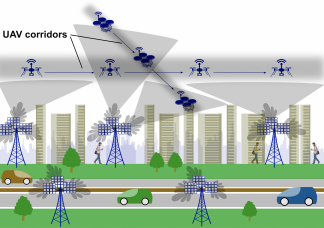Research by two Spanish universities and Nokia Bell Labs in France proposes a new methodology for designing cellular networks that cater for both ground users and UAV corridors based on Bayesian optimization. The research identifies two approaches to address the challenge presented by traditional cellular base stations (BSs) – which are optimized for 2D ground service – and avoiding re-engineering the existing infrastructure to provide 3D connectivity to uncrewed aerial vehicles (UAVs).
The authors say the concept of UAV corridors could be a game changer to providing reliable 3D cellular connectivity in the sky.
- Optimizing cellular networks for UAV corridors via quantization theory
The authors examine a new framework based on quantization theory to design cellular networks optimized for both legacy ground users and uncrewed aerial vehicle (UAV) corridors, dedicated aerial highways for safe UAV flights. The proposed framework leverages antenna tilts and transmit power at each base station to enhance coverage and quality of service among users. They developed a comprehensive mathematical analysis and optimization algorithms for multiple system-level performance metrics, including received signal strength and signal-to-interference-plusnoise ratio. Realistic antenna radiation patterns and propagation channel models are considered, alongside a generic 3D user distribution that allows for performance prioritization on the ground, along UAV corridors, or a desired tradeoff between the two. They demonstrate the efficacy of the proposed framework through case studies, showcasing the non-trivial combinations of antenna tilts and power levels that improve coverage and signal quality along UAV corridors while incurring only a marginal impact on the ground user performance compared to scenarios without UAVs.
- Designing Cellular Networks for UAV Corridors via Bayesian Optimization
The authors of the article present a case study in which they maximize the signal-to-interference-plusnoise ratio (SINR) for both populations of users by optimizing the electrical antenna tilts and the transmit power employed at each BS. The proposed optimized network significantly boosts the UAV performance, with a 23.4 dB gain in mean SINR compared to an all-downtilt, full-power baseline. At the same time, this optimal trade-off nearly preserves the performance on the ground, even attaining a gain of 1.3 dB in mean SINR with respect to said baseline. Thanks to its ability to optimize black-box stochastic functions, the proposed framework is amenable to maximize any desired function of the SINR or even the capacity per area, according to the authors.
(Image: Illustration of a cellular network with downtilted and uptilted BSs providing coverage to ground users as well as UAVs flying along corridors)
For more information visit:




